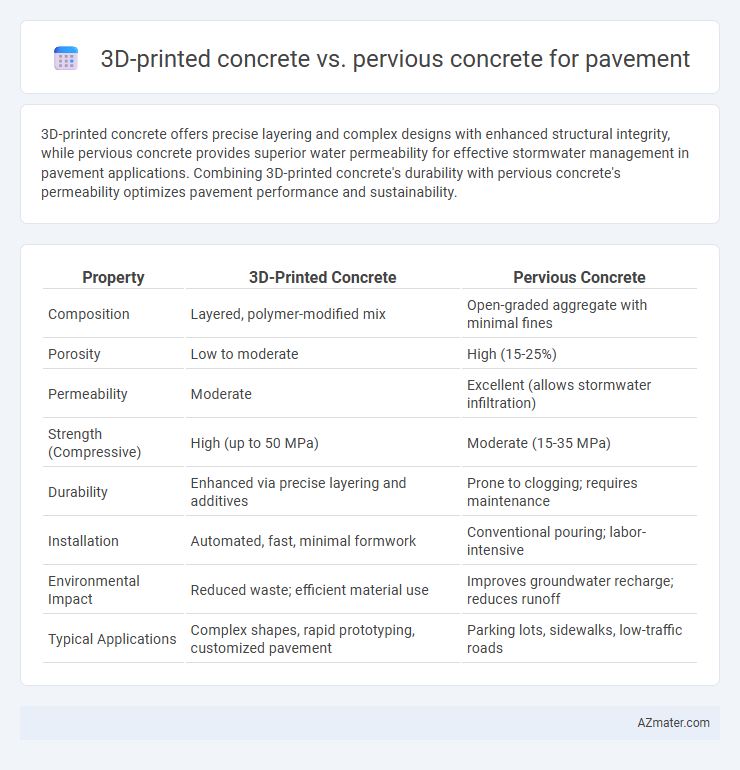3D-printed concrete offers precise layering and complex designs with enhanced structural integrity, while pervious concrete provides superior water permeability for effective stormwater management in pavement applications. Combining 3D-printed concrete's durability with pervious concrete's permeability optimizes pavement performance and sustainability.
Table of Comparison
| Property | 3D-Printed Concrete | Pervious Concrete |
|---|---|---|
| Composition | Layered, polymer-modified mix | Open-graded aggregate with minimal fines |
| Porosity | Low to moderate | High (15-25%) |
| Permeability | Moderate | Excellent (allows stormwater infiltration) |
| Strength (Compressive) | High (up to 50 MPa) | Moderate (15-35 MPa) |
| Durability | Enhanced via precise layering and additives | Prone to clogging; requires maintenance |
| Installation | Automated, fast, minimal formwork | Conventional pouring; labor-intensive |
| Environmental Impact | Reduced waste; efficient material use | Improves groundwater recharge; reduces runoff |
| Typical Applications | Complex shapes, rapid prototyping, customized pavement | Parking lots, sidewalks, low-traffic roads |
Introduction to Innovative Pavement Solutions
3D-printed concrete offers precise, customizable pavement structures with enhanced design flexibility and reduced material waste, making it a cutting-edge solution for urban infrastructure. Pervious concrete improves stormwater management by allowing water infiltration, reducing runoff and mitigating flooding risks in pavement applications. Both technologies contribute to sustainable and resilient pavement systems through innovative engineering approaches.
What is 3D-Printed Concrete?
3D-printed concrete is an innovative construction material created by extruding layers of concrete through a computer-controlled nozzle to form precise, complex shapes without traditional formwork. This technology enables rapid, customizable pavement designs with reduced material waste and improved structural integrity. Unlike pervious concrete, which primarily emphasizes water permeability for stormwater management, 3D-printed concrete focuses on automation and design flexibility in pavement applications.
Understanding Pervious Concrete Technology
Pervious concrete technology employs a porous mixture that allows water to infiltrate the pavement surface, reducing runoff and promoting groundwater recharge compared to traditional dense concrete. Unlike 3D-printed concrete, which emphasizes precise layer-by-layer construction for structural optimization, pervious concrete prioritizes permeability through controlled aggregate size and minimal fines content. This technology is crucial for sustainable urban drainage systems, managing stormwater while maintaining load-bearing capacity suitable for pedestrian and light vehicular traffic.
Material Properties: Strength and Durability Comparison
3D-printed concrete exhibits higher compressive strength and enhanced durability due to its precisely controlled mix design and layer-by-layer deposition, reducing microcracks often found in traditional concretes. Pervious concrete offers lower compressive strength but excels in permeability, enabling effective stormwater management and reducing hydrostatic pressure on pavement surfaces. While 3D-printed concrete is suited for structural durability, pervious concrete's porosity favors applications requiring water infiltration and freeze-thaw resistance in pavement infrastructure.
Sustainability and Environmental Impact
3D-printed concrete offers precise material usage, reducing waste and lowering carbon emissions compared to traditional pervious concrete, which allows water infiltration to minimize runoff and recharge groundwater. Pervious concrete supports sustainable urban drainage systems by enhancing permeability and reducing stormwater pollution. Both materials contribute to sustainable pavement solutions, with 3D-printed concrete optimizing resource efficiency and pervious concrete improving environmental water management.
Installation Processes: Speed and Efficiency
3D-printed concrete offers rapid installation through automated layering technology, reducing labor requirements and minimizing curing time compared to traditional methods. Pervious concrete requires careful mixing and manual placement to maintain its porous structure, which can slow down the installation process. Overall, 3D-printed concrete significantly enhances speed and efficiency in pavement construction by streamlining the laying and curing stages.
Cost Analysis: 3D-Printed vs. Pervious Pavements
3D-printed concrete pavements generally have higher initial costs due to advanced technology and specialized equipment but offer long-term savings through reduced labor and faster construction times. Pervious concrete typically entails lower material costs but may incur additional expenses for maintenance related to clogging and permeability degradation. Analyzing lifecycle costs, 3D-printed pavements can be more cost-effective in urban applications where durability and precision reduce repair frequency compared to pervious concrete surfaces.
Water Management Capabilities
3D-printed concrete offers precise control over pore structure, enabling tailored permeability for effective water infiltration and drainage in pavement applications. Pervious concrete inherently allows water to pass through its interconnected pores, reducing surface runoff and promoting groundwater recharge. When comparing water management capabilities, pervious concrete generally provides superior permeability, but 3D-printed concrete allows customization to optimize stormwater management in urban infrastructure.
Applications and Suitability in Urban Infrastructure
3D-printed concrete offers precise customization and rapid construction capabilities, making it ideal for complex urban infrastructure projects requiring intricate design and minimal labor. Pervious concrete excels in sustainable urban applications by promoting stormwater management and reducing runoff, enhancing environmental resilience in pavements and parking areas. Both materials support urban infrastructure, with 3D-printed concrete favored for structural innovation and pervious concrete prioritized for permeability and groundwater recharge solutions.
Future Trends and Innovations in Pavement Technologies
3D-printed concrete and pervious concrete represent cutting-edge advancements in pavement technologies with distinct future trends shaping their adoption. Innovations in 3D-printed concrete focus on enhancing material strength, reducing construction time, and enabling complex geometries for customized urban infrastructure. Pervious concrete developments aim to improve permeability and durability, supporting sustainable water management and mitigating urban flooding challenges.

Infographic: 3D-printed concrete vs pervious concrete for pavement
 azmater.com
azmater.com